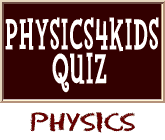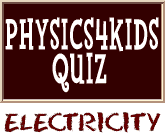Flowing Electrons
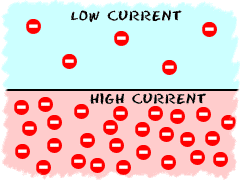 Electric current is very similar to a flowing river. The river flows from one spot to another and the speed it moves is the speed of the current. The size of the current flow is related more to the size of the river than it is to the speed of the river. A river carries more water each second than a stream, even if both flow at the same speed. With electricity, current is a measure of the amount of charge transferred over a period of time. Current is a flow of electrons, or individual negative charges. When charge flows, it carries energy that can be used to do work. Scientists measure current with units called amperes.
Electric current is very similar to a flowing river. The river flows from one spot to another and the speed it moves is the speed of the current. The size of the current flow is related more to the size of the river than it is to the speed of the river. A river carries more water each second than a stream, even if both flow at the same speed. With electricity, current is a measure of the amount of charge transferred over a period of time. Current is a flow of electrons, or individual negative charges. When charge flows, it carries energy that can be used to do work. Scientists measure current with units called amperes.
Current and Heat
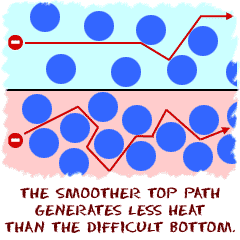 One of the results of current is the heating of the conductor. When an electric stove heats up, it's because of the flow of current. The electrons have a mass (however small), and when they move through the conductor, there are collisions that produce heat. The more electrons bumping into the atoms of the conductor, the more heat is created, so higher current generally means greater heat.
One of the results of current is the heating of the conductor. When an electric stove heats up, it's because of the flow of current. The electrons have a mass (however small), and when they move through the conductor, there are collisions that produce heat. The more electrons bumping into the atoms of the conductor, the more heat is created, so higher current generally means greater heat.
Scientists used to think that the flow of current always heated up the object, but with modern superconductors, that is not always true, or at least not as true as with normal materials. Superconducting materials seem to have less interaction between atoms and current, so the moving charges lose much less energy.
Spaces Between Atoms
Everything that is matter can conduct electricity, but not everything does it well. Scientists use the terms conductors, insulators, and semi-conductors. The labels are used to describe how easily energy is transferred through the object by moving charge. The spaces between the atoms, as well as the type of atoms, determines whether an object a good conductor or a good insulator (poor conductor).Usable Current
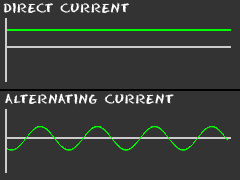 There are two main kinds of electric current, direct current (DC) and alternating current (AC). They are easy to remember. Direct current is a flow of charge always in one direction. Alternating current is a flow of charge back and forth, changing its direction many times in one second. Batteries produce DC current, while the outlets in our homes use AC current.
There are two main kinds of electric current, direct current (DC) and alternating current (AC). They are easy to remember. Direct current is a flow of charge always in one direction. Alternating current is a flow of charge back and forth, changing its direction many times in one second. Batteries produce DC current, while the outlets in our homes use AC current.
Be very careful if you work with electricity. NEVER touch the plugs in your house. That electricity is very powerful and it can hurt you… badly. Electricity from batteries can also injure you. We have burned ourselves when working with batteries and electromagnets, so we know what can happen. To be safe, go get an adult to help you with any experiments.
Or search the sites for a specific topic.
- Overview
- Charges
- Conductors
- Electric Fields
- Magnetic Fields
- Current
- Resistance
- Faraday's Law
- Coulomb's Law
- Magnets
- DC Power
- AC Power
- More Topics

Algebra and Arrays in Electricity (NASAConnect Video)

Useful Reference Materials
Encyclopedia.com:http://www.encyclopedia.com/topic/electric_current.aspx
Wikipedia:
http://en.wikipedia.org/wiki/Electric_current
Encyclopædia Britannica:
hhttp://www.britannica.com/EBchecked/topic/182467/electric-current




